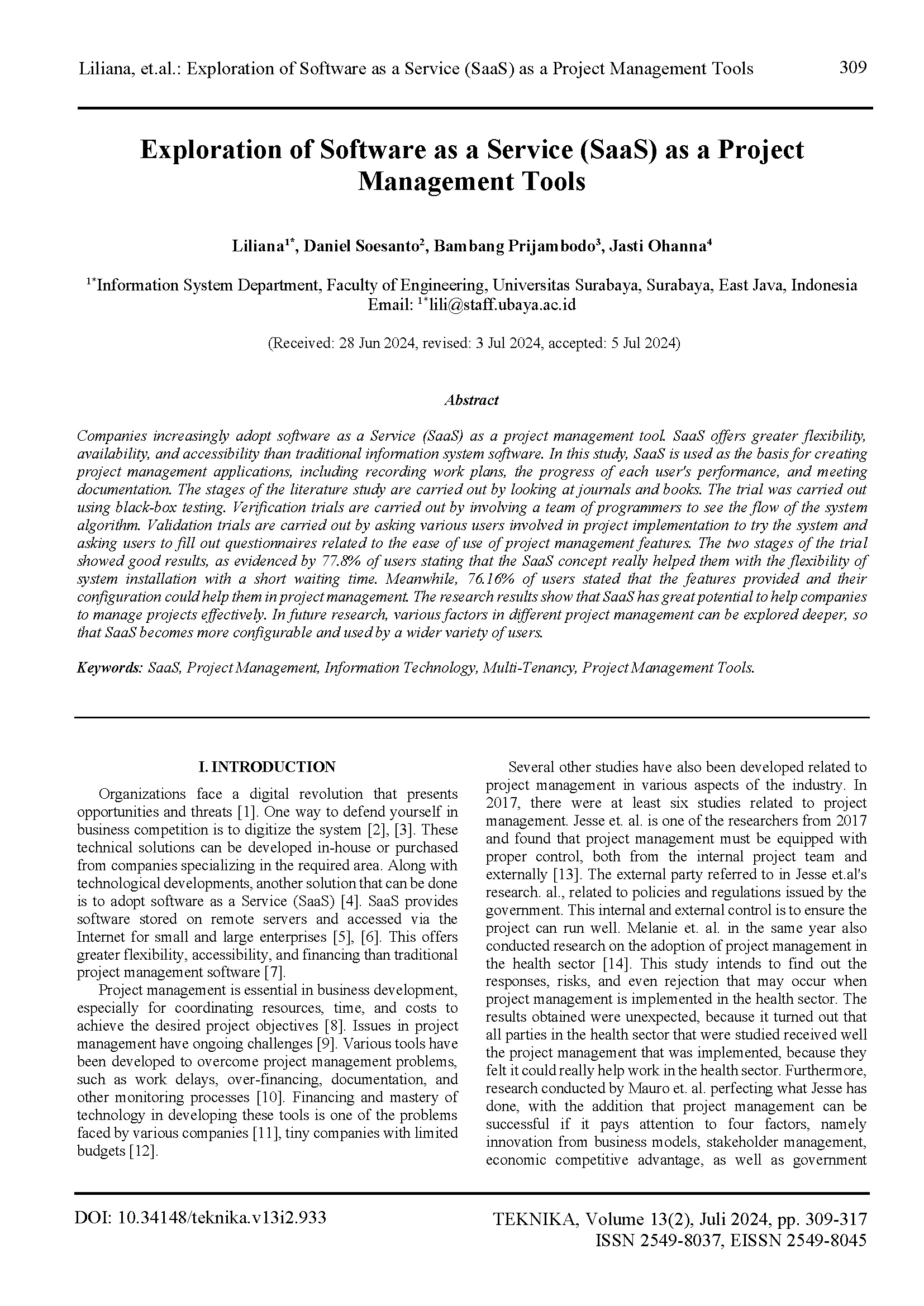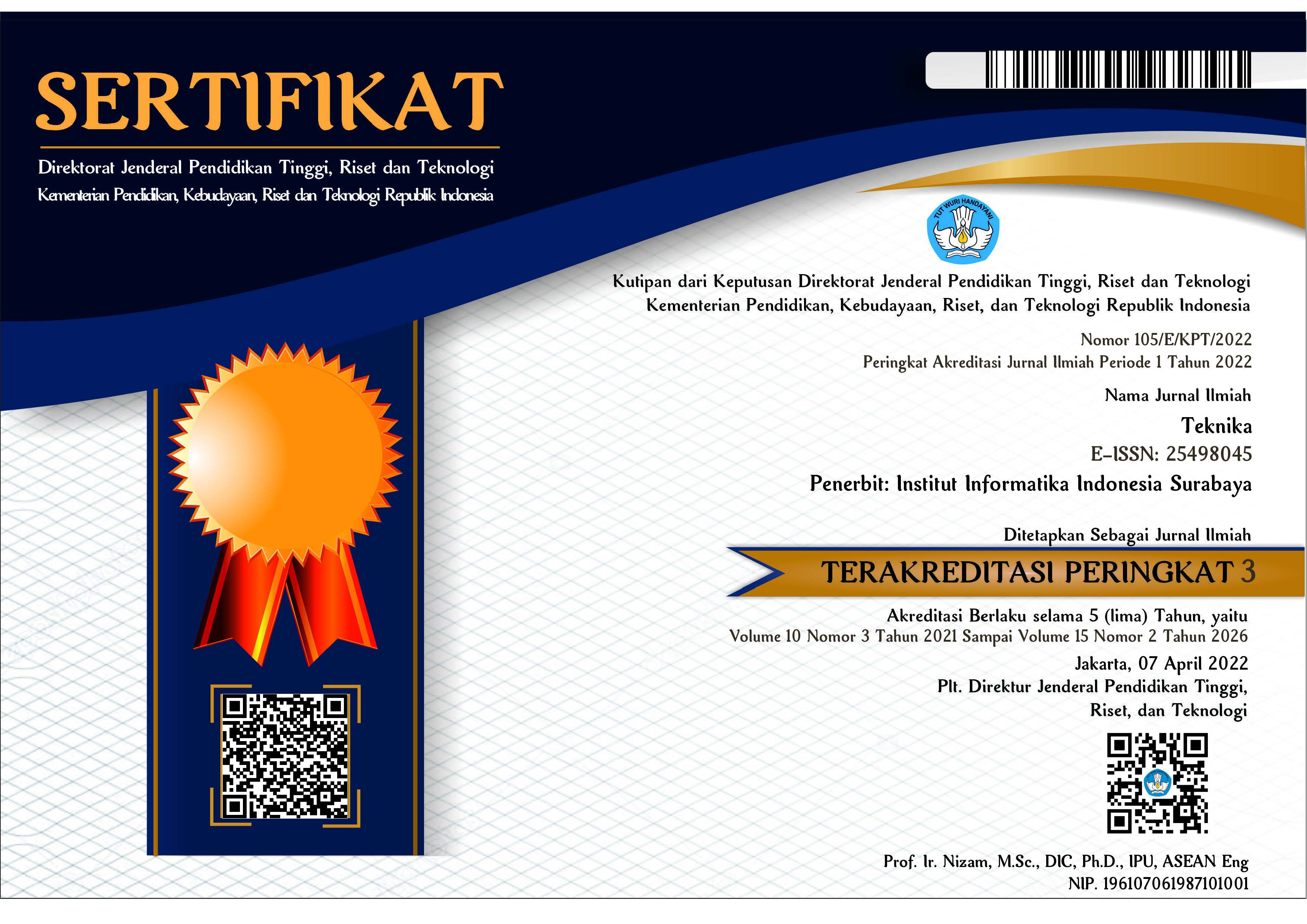Exploration of Software as a Service (SaaS) as a Project Management Tools
DOI:
https://doi.org/10.34148/teknika.v13i2.933Keywords:
SaaS, Project Management, Information Technology, Multi-Tenancy, Project Management ToolsAbstract
Companies increasingly adopt software as a Service (SaaS) as a project management tool. SaaS offers greater flexibility, availability, and accessibility than traditional information system software. In this study, SaaS is used as the basis for creating project management applications, including recording work plans, the progress of each user's performance, and meeting documentation. The stages of the literature study are carried out by looking at journals and books. The trial was carried out using black-box testing. Verification trials are carried out by involving a team of programmers to see the flow of the system algorithm. Validation trials are carried out by asking various users involved in project implementation to try the system and asking users to fill out questionnaires related to the ease of use of project management features. The two stages of the trial showed good results, as evidenced by 77.8% of users stating that the SaaS concept really helped them with the flexibility of system installation with a short waiting time. Meanwhile, 76.16% of users stated that the features provided and their configuration could help them in project management. The research results show that SaaS has great potential to help companies to manage projects effectively. In future research, various factors in different project management can be explored deeper, so that SaaS becomes more configurable and used by a wider variety of users.
Downloads
References
M. Kozak-holland and C. Procter, Managing Transformation Projects : Tracing Lessons from the Industrial to the Digital Revolution. Palgrave Macmillan, 2020.
R. I. N. Budisantoso and A. Sumarwan, “Entrepreneurial Modes towards Information Technology Applications in Business during Pandemic Covid-19 Based on Indonesia SMEs’ Stories,” Indones. J. Inf. Syst., vol. 4, no. 2, pp. 165–173, 2022, doi: 10.24002/ijis.v4i2.4840.
J. Kobus, M. Westner, S. Strahringer, and D. Strode, “Enabling digitization by implementing Lean IT: lessons learned,” TQM J., vol. 30, no. 6, pp. 764–778, 2018, doi: 10.1108/TQM-02-2018-0026.
W. Axbrink, Factors Behind Successful Software-as-a-Service Integrations. KTH Royal Institute of Technology, 2022.
T. Kaikkonen, “SaaS Application Integration Challenges,” no. February, pp. 1–74, 2019, [Online]. Available: https://www.theseus.fi/bitstream/handle/10024/160365/Kaikkonen_Tiina.pdf?sequence=1.
K. N. Rao and C. S. Reddy, “an Integrated Framework for Software Defect Analysis With Aware of Saas Provisioning in Cloud Environment Using Madm Methods,” Adv. Appl. Math. Sci., vol. 20, no. 12, pp. 3269–3287, 2021.
P. R. Palos-Sanchez, F. J. Arenas-Marquez, and M. Aguayo-Camacho, “Cloud Computing (SaaS) Adoption as a Strategic Technology: Results of an Empirical Study,” Mob. Inf. Syst., vol. 2017, 2017, doi: 10.1155/2017/2536040.
Project Management Institute, A Guide to The Project Management Body of Knowledge, 6th ed., vol. 6. Project Management Institute, Inc., 2017.
A. Jalali Sohi, M. Bosch-Rekveldt, and M. Hertogh, “Does flexibility in project management in early project phases contribute positively to end-project performance?,” Int. J. Manag. Proj. Bus., vol. 13, no. 4, pp. 665–694, 2020, doi: 10.1108/IJMPB-07-2019-0173.
R. Aguda, S. Bonilla, J. Ben Hmida, and E. D. Revellame, “Challenges and Opportunities in Developing Project Management Decision-Making Tools,” J. Eng. Proj. Prod. Manag., vol. 11, no. 2, pp. 127–138, 2021, doi: 10.2478/jeppm-2021-0013.
A. P. Utomo, M. Arifin, and F. Nugraha, “E-commerce Applications based on SaaS For MSMEs in Kudus District E-commerce Applications based on SaaS For MSMEs in Kudus District,” no. March 2019, 2018, doi: 10.4108/eai.24-10-2018.2280632.
S. Baul, M. Rana, S. Adan, N. Tafannum, and F. Alam, “Analyzing Different Software Project Management Tools and Proposing A New Project Management Tool Using Process Re-engineering On Open-source and SAAS Platforms for A Developing Country Like Bangladesh,” vol. 9, no. 7, pp. 29–37, 2022.
J. Kivilä, M. Martinsuo, and L. Vuorinen, “Sustainable project management through project control in infrastructure projects,” Int. J. Proj. Manag., vol. 35, no. 6, pp. 1167–1183, 2017, doi: 10.1016/j.ijproman.2017.02.009.
M. Lavoie-Tremblay et al., “Innovation in health service management: Adoption of project management offices to support major health care transformation,” J. Nurs. Manag., vol. 25, no. 8, pp. 657–665, 2017, doi: 10.1111/jonm.12505.
M. L. Martens and M. M. Carvalho, “Key factors of sustainability in project management context: A survey exploring the project managers’ perspective,” Int. J. Proj. Manag., vol. 35, no. 6, pp. 1084–1102, 2017, doi: 10.1016/j.ijproman.2016.04.004.
K. E. Papke-Shields and K. M. Boyer-Wright, “Strategic planning characteristics applied to project management,” Int. J. Proj. Manag., vol. 35, no. 2, pp. 169–179, 2017, doi: 10.1016/j.ijproman.2016.10.015.
A. H. I. Lee, H. Y. Kang, and T. T. Huang, “Project Management Model for Constructing a Renewable Energy Plant,” Procedia Eng., vol. 174, pp. 145–154, 2017, doi: 10.1016/j.proeng.2017.01.186.
M. Radujković and M. Sjekavica, “Project Management Success Factors,” Procedia Eng., vol. 196, no. June, pp. 607–615, 2017, doi: 10.1016/j.proeng.2017.08.048.
O. Prydatko, Y. Borzov, I. Solotvinskyi, O. Smotr, and O. Didyk, “Informational System of Project Management in the Areas of Regional Security Systems’ Development,” Proc. 2018 IEEE 2nd Int. Conf. Data Stream Min. Process. DSMP 2018, no. 1, pp. 187–192, 2018, doi: 10.1109/DSMP.2018.8478543.
N. Kavishe and N. Chileshe, “Identifying project management practices and principles for Public-Private Partnerships in housing projects: The case of Tanzania,” Sustain., vol. 10, no. 12, 2018, doi: 10.3390/su10124609.
A. Abbasi and A. Jaafari, “Project management research and industry-focused innovations,” J. Mod. Proj. Manag., vol. 6, no. 1, pp. 60–68, 2018, doi: 10.19255/JMPM01606.
E. Levin, T. N. Quach, and P. Thaichon, “Enhancing client-agency relationship quality in the advertising industry – an application of project management,” J. Bus. Ind. Mark., vol. 34, no. 2, pp. 463–473, 2019, doi: 10.1108/JBIM-08-2017-0186.
A. G. Chofreh, F. A. Goni, M. N. Malik, H. H. Khan, and J. J. Klemeš, “The imperative and research directions of sustainable project management,” J. Clean. Prod., vol. 238, 2019, doi: 10.1016/j.jclepro.2019.117810.
F. Marle, “An assistance to project risk management based on complex systems theory and agile project management,” Complexity, vol. 2020, 2020, doi: 10.1155/2020/3739129.
V. Jiménez, P. Afonso, and G. Fernandes, “Using agile project management in the design and implementation of activity-based costing systems,” Sustain., vol. 12, no. 24, pp. 1–23, 2020, doi: 10.3390/su122410352.
C. S. Noteboom, M. Ofori, S. Kruttika, and O. El-Gayar, “Agile Project Management: A Systematic Literature Reviewof Adoption Drivers and Critical Success Factors,” vol. 0, pp. 6775–6784, 2021.
R. Komalasari, “Manfaat Teknologi Informasi dan Komunikasi di Masa Pandemi Covid 19,” Tematik, vol. 7, no. 1, pp. 38–50, 2020, doi: 10.38204/tematik.v7i1.369.
M. Pech et al., “Experimentation of the SoBeezy program in older adults during the COVID-19 pandemic: what lessons have we learned?,” JMIR Form. Res., 2022, [Online]. Available: http://www.epistemonikos.org/documents/dfd704217e35ef2860ef6d5d3fd76dad9eea70ff.
J. Aguirre-Peralta, M. Rivas-Zavala, and W. Ugarte, “Speech to Text Recognition for Videogame Controlling with Convolutional Neural Networks,” no. Icpram, pp. 948–955, 2023, doi: 10.5220/0011782900003411.
R. Nayak and R. Joshi, “Contextual Hate Speech Detection in Code Mixed Text using Transformer Based Approaches,” CEUR Workshop Proc., vol. 3159, pp. 217–225, 2021.
D. Soesanto, B. Hartanto, and Melisa, “Meeting Assistant System Berbasis Teknologi Speech-to-Text,” Teknika, vol. 10, no. 1, pp. 1–7, 2021, doi: 10.34148/teknika.v10i1.307.
M. Alemu, A. Adane, B. K. Singh, and D. P. Sharma, “Cloud-based outsourcing framework for efficient IT project management practices,” Int. J. Adv. Comput. Sci. Appl., vol. 11, no. 9, pp. 153–164, 2020, doi: 10.14569/IJACSA.2020.0110918.
T. Seymour and S. Hussein, “The History Of Project Management,” Int. J. Manag. Inf. Syst., vol. 18, no. 4, p. 233, 2014, doi: 10.19030/ijmis.v18i4.8820.
M. Ayat, M. Imran, A. Ullah, and C. W. Kang, “Current trends analysis and prioritization of success factors: a systematic literature review of ICT projects,” Int. J. Manag. Proj. Bus., vol. 14, no. 3, pp. 652–679, 2021, doi: 10.1108/IJMPB-02-2020-0075.
S. Armenia, R. M. Dangelico, F. Nonino, and A. Pompei, “Sustainable project management: A conceptualization-oriented review and a framework proposal for future studies,” Sustain., vol. 11, no. 9, 2019, doi: 10.3390/su11092664.
S. Kamarudin, A. H. Ahmad Khalili, Z. F. Abd. Aziz, K. A. Kamarudin, and A. N. A. Wahab, “Exploring of Potential of Cloud Computing for Small and Medium Enterprises,” Indones. J. Inf. Syst., vol. 4, no. 2, pp. 98–108, 2022, doi: 10.24002/ijis.v4i2.5487.
G. Shroff, Enterprise Cloud Computing: Technology, Architecture, Applications, 1st ed. CAMBRIDGE UNIVERSITY PRESS, 2010.
S. Tongsuksai, S. Mathrani, and K. Weerasinghe, “Critical success factors and challenges for cloud ERP system implementations in SMEs: A vendors’ perspective,” 2021 IEEE Asia-Pacific Conf. Comput. Sci. Data Eng. CSDE 2021, no. January 2022, 2021, doi: 10.1109/CSDE53843.2021.9718428.
S. Aleem, R. Batool, F. Ahmed, and A. Khattak, “Guidelines for key organizational factors for saas organizations,” ACM Int. Conf. Proceeding Ser., pp. 83–87, 2019, doi: 10.1145/3372454.3372475.
J. vom Brocke, A. Hevner, and A. Maedche, “Introduction to Design Science Research,” no. September, pp. 1–13, 2020, doi: 10.1007/978-3-030-46781-4_1.
P. Dybka, “Crow’s Foot Notation,” Vertabelo SA, 2020. https://www.vertabelo.com/blog/crow-s-foot-notation/.
M. Von Rosing, S. A. White, F. Cummins, and H. De Man, Business process model and notation-BPMN, vol. 1, no. January. Object Management Group, 2014.
S. Nidhra, “Black Box and White Box Testing Techniques - A Literature Review,” Int. J. Embed. Syst. Appl., vol. 2, no. 2, pp. 29–50, 2012, doi: 10.5121/ijesa.2012.2204.
L. South, D. Saffo, O. Vitek, C. Dunne, and M. A. Borkin, “Effective Use of Likert Scales in Visualization Evaluations: A Systematic Review,” Comput. Graph. Forum, vol. 41, no. 3, pp. 43–55, 2022, doi: 10.1111/cgf.14521.























